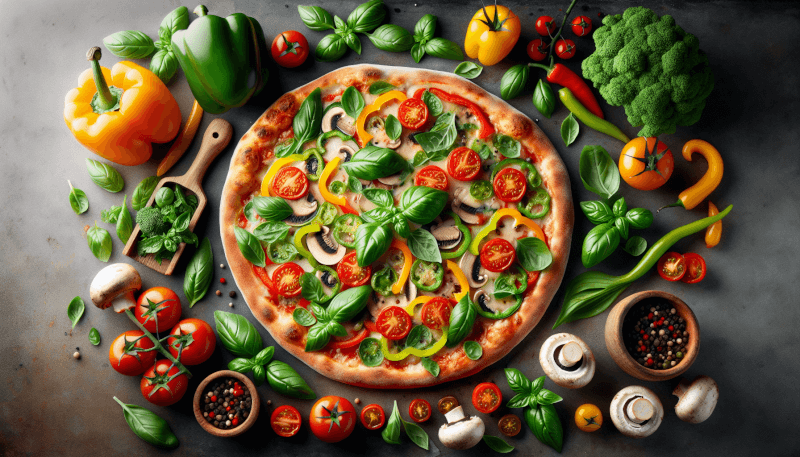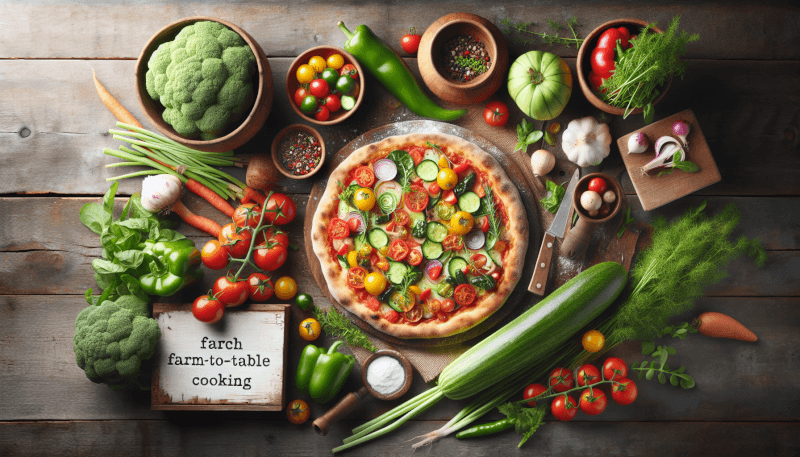You’re in for a mouthwatering treat with our article on how to make the perfect pizza using fresh garden ingredients. Whether you’re a seasoned cook or a beginner in the kitchen, this guide will help you create a pizza that’s bursting with flavors and made with love. Discover the secrets to choosing the right garden-fresh ingredients, master the art of creating a flavorful sauce, and learn how to achieve the perfect crust every time. Get ready to impress your friends and family with a homemade pizza that will leave them craving for more. Let’s dive into this delicious journey together!

Selecting the Ingredients
Choosing the Right Flour
When it comes to making the perfect pizza dough, choosing the right flour is essential. Opt for a high-quality all-purpose flour or bread flour. These types of flour have a higher protein content, which will give your dough a nice chewy texture. Avoid using cake or pastry flour, as they won’t give you the desired results.
Picking the Perfect Tomatoes
The key to a flavorful pizza sauce is using fresh and ripe tomatoes. Look for tomatoes that are firm, yet slightly soft to the touch. Avoid using tomatoes that are mushy or have any signs of mold. If you can, try to get your hands on vine-ripened tomatoes or heirloom tomatoes for an extra burst of flavor.
Selecting Fresh Herbs
Fresh herbs are a game-changer when it comes to making a delicious pizza. Opt for herbs like basil, oregano, thyme, or rosemary. Look for bright green leaves with no wilting or browning. You can either grow your own herbs at home or purchase them from a local farmer’s market for the freshest options.
Opting for Organic Produce
Using organic produce for your pizza toppings is a great way to ensure that you are getting the best quality ingredients. Organic vegetables and meats are free from harmful pesticides and antibiotics, making them a healthier choice. Additionally, organic produce tends to have a more robust flavor, enhancing the overall taste of your pizza.
Preparing the Pizza Dough
Gathering Ingredients
Before you start making the dough, gather all the necessary ingredients. This includes flour, yeast, sugar, salt, olive oil, and warm water. Having everything ready will make the process much smoother.
Measuring Flour and Other Dry Ingredients
Accurate measurements are crucial when it comes to making pizza dough. Use a kitchen scale or measuring cups to measure the flour and other dry ingredients precisely. Too much or too little flour can affect the texture and consistency of the dough.
Mixing the Dough
In a large mixing bowl, combine the flour, yeast, sugar, and salt. Mix them together until well combined. Slowly add in the warm water and olive oil, stirring continuously until a sticky dough forms.
Kneading the Dough
Transfer the dough onto a clean, lightly floured surface. Start kneading the dough by gently pushing it away from you with the palm of your hand. Fold the dough over itself and repeat the process for about 8-10 minutes. Kneading helps develop the gluten in the dough, giving it elasticity and a nice chewy texture.
Letting the Dough Rest
After kneading, shape the dough into a ball and place it in a lightly oiled bowl. Cover it with a damp cloth or plastic wrap and let it rest in a warm area for at least an hour. This allows the dough to rise and develop its flavor.
Creating the Pizza Sauce
Blending the Tomatoes
To create a smooth and flavorful pizza sauce, blend the fresh tomatoes in a blender or food processor until they reach a desirable consistency. Some prefer a chunkier sauce, while others prefer a smoother texture. Blend to your preference.
Seasoning the Sauce
Add your favorite seasonings to the blended tomatoes. This can include garlic, oregano, salt, pepper, and a drizzle of olive oil. Taste the sauce and adjust the seasonings according to your preference.
Cooking the Sauce
Transfer the sauce to a saucepan and cook it over low heat for about 20-30 minutes. This will help the flavors meld together and the sauce to thicken slightly. Stir occasionally to prevent burning.
Allowing the Flavors to Blend
After cooking, remove the sauce from the heat and let it cool for a few minutes. Allowing the sauce to sit for a while will further enhance the flavor as the ingredients meld together.
Cooling and Storing the Sauce
Once the sauce has cooled, transfer it to an airtight container and refrigerate it until you’re ready to use it. Homemade pizza sauce can be stored in the refrigerator for up to a week, allowing you to enjoy homemade pizza any time.
Choosing Toppings
Considering Seasonal Vegetables
When selecting toppings for your pizza, choose seasonal vegetables for the freshest flavors. This could include bell peppers, mushrooms, onions, zucchini, or even fresh tomatoes. Experiment with different combinations to find your favorite medley.
Exploring Different Cheeses
Cheese is a crucial component of any pizza, and there are countless options to choose from. Mozzarella is a classic choice, but don’t be afraid to explore other varieties such as cheddar, feta, or goat cheese. Each cheese brings its unique flavor and texture to the pizza.
Experimenting with Meats
If you’re a meat lover, there’s no shortage of options for you to choose from. Consider adding pepperoni, sausage, bacon, or even prosciutto to your pizza. Different meats can add a savory and salty element to your creation.
Adding Herbs and Spices
Fresh herbs and spices can elevate the flavors of your pizza. Add a sprinkle of basil, oregano, or even red pepper flakes to give your pizza an extra punch. Experiment with different combinations to find the perfect balance of flavors.

Preparing the Pizza Stone
Cleaning the Pizza Stone
Before using your pizza stone, it’s important to clean it thoroughly. Remove any debris or residue from previous uses by gently scrubbing it with warm water and a brush. Avoid using soap or harsh chemicals, as they can be absorbed by the stone and affect the taste of your pizza.
Seasoning the Stone
To prevent sticking and enhance the flavor, it’s recommended to season your pizza stone. Lightly coat the surface with a thin layer of olive oil and let it sit for a few hours or overnight. This will create a non-stick surface and add a hint of flavor to your pizza crust.
Preheating the Stone
Preheating the pizza stone is crucial to achieving a crispy crust. Place the stone in a preheated oven and let it warm up for at least 30 minutes. This ensures that the stone is hot enough to cook the dough evenly and create a nice golden crust.
Rolling and Stretching the Dough
Dividing and Shaping the Dough
Once the dough has rested and risen, divide it into portions depending on the size of the pizza you want to make. Shape each portion into a round ball and let them sit for a few minutes to relax the gluten before rolling.
Rolling the Dough
Lightly dust your work surface with flour and use a rolling pin to roll one dough portion into your desired thickness. Start from the center and roll outward, rotating the dough as you go to maintain an even thickness.
Stretching the Dough
For a thin-crust pizza, stretching the dough is a preferred method. Place the rolled dough on your knuckles, allowing the weight to stretch the dough. Gently rotate and stretch the dough until it reaches the desired size and thickness.
Avoiding Overstretching
It’s important not to overstretch the dough, as it can thin out too much and become difficult to handle. If the dough starts tearing or becoming too thin, simply gather it back into a ball and start again.

Assembling the Pizza
Preparing the Work Surface
Before assembling your pizza, ensure that your work surface is well-floured or lightly oiled to prevent the dough from sticking. This will also make it easier to transfer the pizza to the oven.
Transferring the Dough
Carefully lift the stretched dough and transfer it onto a pizza peel or baking sheet lined with parchment paper. This will ensure that the pizza slides easily onto the preheated pizza stone in the oven.
Spreading the Sauce
Take a spoonful of your homemade pizza sauce and spread it evenly over the surface of the dough, leaving a small border around the edges. Use the back of the spoon in circular motions to achieve an even spread.
Arranging the Toppings
Now comes the fun part – adding your chosen toppings! Start with your cheese, followed by the vegetables and meats. Be creative and feel free to arrange the toppings in a visually appealing way.
Considering Layering Techniques
Layering your toppings strategically can contribute to a well-balanced set of flavors. For example, place meat toppings closer to the cheese and vegetables on top to prevent them from becoming soggy.
Baking the Pizza
Preheating the Oven
Preheat your oven to the highest temperature setting possible, usually around 500°F (260°C). A hot oven helps cook the pizza quickly and creates a crispy crust.
Placing the Pizza on the Stone
Using a pizza peel or the back of a baking sheet, carefully transfer the assembled pizza onto the preheated pizza stone in the oven. The hot stone will ensure even cooking and a nicely browned crust.
Monitoring the Temperature
Keep an eye on the temperature of your pizza by using an oven thermometer. This allows you to adjust the temperature if needed and ensures that your pizza cooks perfectly.
Timing the Baking Process
The baking time can vary depending on the thickness of your dough and the number of toppings. Typically, a thin-crust pizza will take around 10-12 minutes to bake, while a thicker crust may need 15-20 minutes. Keep an eye on the crust and remove the pizza once the cheese is melted and bubbly, and the edges are golden brown.
Rotating the Pizza for Even Cooking
To ensure even cooking, rotate the pizza halfway through the baking process. This will help prevent any hot spots in your oven and give your pizza an evenly browned crust.

Adding Finishing Touches
Sprinkling with Fresh Herbs
After removing the pizza from the oven, take some fresh herbs like basil or oregano and sprinkle them over the top. The heat from the pizza will release the aromatic oils from the herbs, adding an extra burst of flavor to your creation.
Drizzling with Olive Oil
For an added touch of richness, drizzle a small amount of extra virgin olive oil over the top of the pizza. This will enhance the flavors and give your pizza a glossy finish.
Cracking Fresh Pepper
Freshly cracked black pepper is a simple yet effective way to elevate the flavors of your pizza. Give your pizza a sprinkle of freshly cracked pepper to add a subtle hint of heat and complexity.
Adding a Pinch of Sea Salt
A final touch to bring out the flavors is a pinch of high-quality sea salt. Sprinkle a small amount of sea salt over the pizza to enhance the taste of each ingredient and add a satisfying crunch.
Perfecting Slicing and Serving
Using a Sharp Pizza Cutter
Before slicing your pizza, make sure you have a sharp pizza cutter or chef’s knife. A dull blade can tear the crust and disturb the toppings, resulting in a less visually appealing slice.
Creating Desired Slice Sizes
You have the freedom to cut your pizza into traditional wedges or experiment with square cuts. Slice the pizza according to your preference and the number of people you’re serving.
Plating and Garnishing
Transfer the slices onto serving plates or a large platter. If desired, garnish the platter with fresh herbs, grated cheese, or a drizzle of olive oil for an elegant presentation.
Accompanying with Dipping Sauces
If you want to take your pizza experience to the next level, serve it with a variety of dipping sauces. Classic marinara sauce, garlic aioli, or even a spicy ranch sauce can complement the flavors of your homemade pizza and provide an extra burst of deliciousness.
Making the perfect pizza with fresh garden ingredients takes time, practice, and a lot of love. By carefully selecting the right ingredients, preparing the dough and sauce with care, and paying attention to the cooking process, you can create your very own pizza masterpiece. So, put on your apron, gather your favorite toppings, and get ready to enjoy a homemade pizza that will impress your friends and family!



